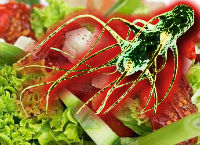Organism Details:
Shape and Size
�1�2�0 ��7�0�0� �µ�m� �i�n� �l�e�n�g�t�h�.�
� �v�a�r�i�a�b�l�e� �i�n� �s�h�a�p�e� �b�u�t� �a�r�e� �o�f�t�e�n� �d�e�s�c�r�i�b�e�d� �a�s� �"�s�p�o�o�n�-�s�h�a�p�e�d�"�.
Genome Information
Aspergillus versicolor culture-collection CECT:2664 FluG (fluG) gene, partial cds ( GI:383931452) has a 269 bp linear DNA .
Food Source
A. versicolor has been reported from a very wide variety of foods. It occurs at harvest in some crops such as wheat, but is much more commonly isolated from stored commodities, particularly wheat, corn, flour and rice. It has also been found in a variety of nuts, fermented and cured meats and biltong, spices and cheese
Pathological Factor
Sterigmatocystin is produced by several species of fung, but A. Versicolor responsible to cause foodborne illness.Sterigmatocystin has the potential to cause human liver cancer. Natural occurrence of sterigmatocystin has been found
in rice, wheat and barley. This toxin has low acute oral toxicity because it is relatively insoluble in water and gastric juices. But even low doses can cause tumor and pathological changes.
Disease
Detection of a disease syndrome due to this mycotoxin appears to be a very difficult epidemiological problem indeed.
|








